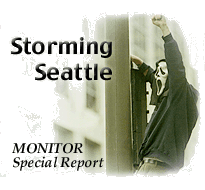
Black Flag Over Seattle
by Paul de Armond
 |
by Paul de Armond |
|
Read
any war memoir, and notice that veterans almost always comment on the battlefield stillness before the fighting begins. Often it is the only personal note in the writing; the rest of the account describes history book heroism and savagery, troop movements and general's strategies, cannonfire and the screams of the injured. But these preceeding hours of quietude always seem as memorable as the carnage that follows.
Welcome to Seattle Washington, as dawn rises on Tuesday, November 30, 1999, and about five hundred members of law enforcement prepared for duty. Sharing their own moments of stillness are about 35,000 protesters plus 15,000 members of organized labor. The police are outnumbered 10 to 1. The evening before, the forces had aligned themselves into camps. There was the Direct Action Network (a coalition of enviro and human rights groups), which planned to shut down the WTO conference by swarming the streets. There was the AFL-CIO, which planned to hold a rally and parade in an effort to influence national trade policy -- and the upcoming presidential elections. There was the Seattle Police Department, tasked with preventing the protests while allowing the labor parade. There was the camp of outside law enforcement agencies, champing at the bit to enter into the fray -- but as long as the SPD maintained order, they would be forced to sit on the sidelines. And milling around the edges were the Black Blocs, fondling their crowbars and dreaming of chaos. What would happen next was anybody's guess -- but as old veterans say, no plan of battle survives contact with the opposition. We present the story of the Battle of Seattle in 20 parts, meant to be read in sequence. Please don't skip ahead; each section builds on important details revealed before. |
|
Albion Monitor
February 29, 2000 (http://www.monitor.net/monitor) All Rights Reserved. Contact rights@monitor.net for permission to use in any format. |